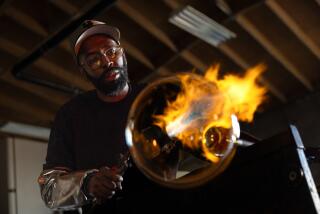He Carved His Own Niche in Art World
HAVRE DE GRACE, Md. — R. Madison Mitchell, who will be 90 on March 11, held 16 funerals last month in the same mortuary he has owned and operated for 67 years.
But it is not because of Mitchell’s funeral home that Americans from across the land make pilgrimages to Havre de Grace, a small town on the northern end of Chesapeake Bay, to visit the old man. It’s because of his ducks and geese.
Mitchell is the dean of a unique American folk art; he’s the grand old man of decoy carving. Until five years ago, when his eyesight weakened to the point that he could no longer safely whittle decoys, he carved his ducks between funerals.
Now he spends part of his time at the nation’s only decoy museum, giving tours as he describes the 1,400 decoys on display.
“Havre de Grace, French for beautiful harbor, is the decoy capital of the world,” he said. “The largest concentration of decoy carvers anywhere on Earth is here, and I have taught every one of them.”
As he sat in the museum this day, Mitchell observed brothers Bob and Charley Jobes, 28, whittling decoy duck heads. Wood shavings littered the two carvers’ laps as well as the floor.
Two large Canada geese decoys the brothers had carved were at their feet. “How you doing, Madison?” Bob Jobes, 31, inquired of Mitchell when he pulled up a chair.
“Half and half,” responded the old man, a puckish grin creasing his face, adding mischievously as he viewed the wooden geese: “You boys are coming along. I think there’s a future in it for you.”
Mitchell was giving the brothers a hard time, of course: Their work is in great demand nationwide.
“Madison isn’t stretching it when he says he taught every one of the 40 decoy carvers in this neck of the woods,” Bob Jobes said. “All the Havre de Grace and Susquehanna Flats carvers learn their craft in Madison’s shop. My brother Joey is also a carver; so is my dad.”
The town of Havre de Grace thinks so much of its master decoy carver that city officials named a street in his honor. R. Madison Mitchell Street leads to the decoy museum, which opened five years ago.
The museum displays a wax figure of Mitchell, depicting him at age 85 surrounded by examples of his work, as well as a wax tableaux of him with three other carvers working their art around a pot-bellied stove.
A $250,000 addition to the decoy museum is scheduled to be dedicated during the 10th annual Havre de Grace Decoy Festival, May 3-5, and will include Mitchell’s restored decoy shop with all his tools and another figure of him. The festival annually attracts at least 200 decoy carvers and 6,000 decoy fanciers.
The world’s oldest-known decoys, made at least 1,000 years ago, were discovered in Nevada’s Lovelock Cave in the early 1920s. Indians made decoys from dried bird skins, feathers and bulrush, and early American settlers learned the art of carving decoys from them.
Mitchell estimates he has carved more than 100,000 decoys since his cousin Sam Barnes, a well-known carver born in 1843, taught him the craft. During his early years, Mitchell’s cedar and white pine decoys sold for as little as 50 cents and $1 each. He received as much as $200 to $350 each for the lifelike decoys he did toward the end of his career.
Several of his ducks and geese have been resold by collectors in recent years for as much as $10,000 each.
“When I first started, decoys were carved exclusively for gunning (hunting). Now sportsmen, nature lovers, art collectors, ornithologists, investors and people in general buy them as decorative pieces,” Mitchell explained. “Prices some of the decoys command are unbelievable.”
More to Read
Sign up for Essential California
The most important California stories and recommendations in your inbox every morning.
You may occasionally receive promotional content from the Los Angeles Times.








